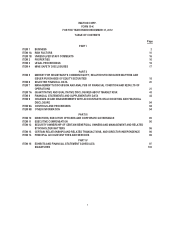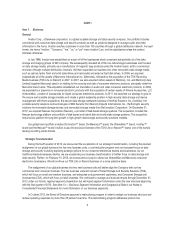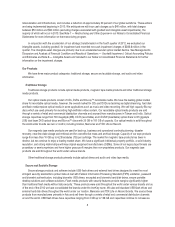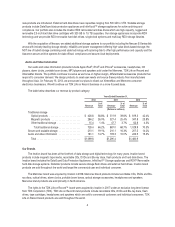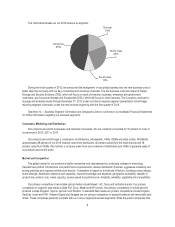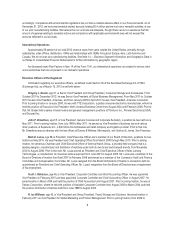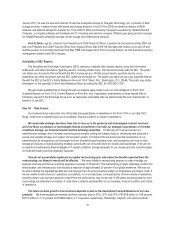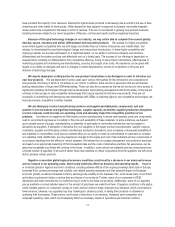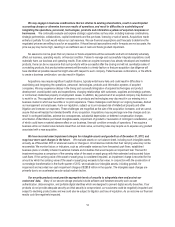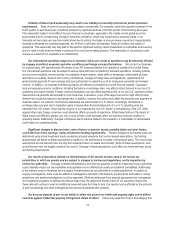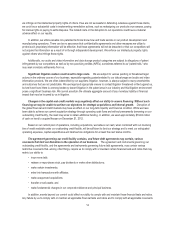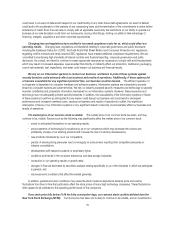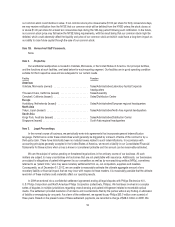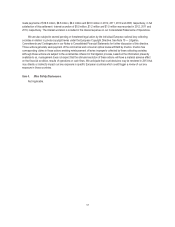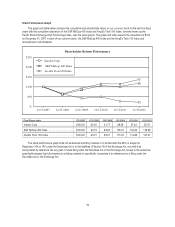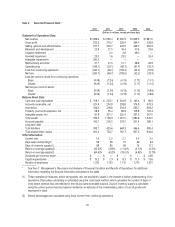Memorex 2012 Annual Report Download - page 14
Download and view the complete annual report
Please find page 14 of the 2012 Memorex annual report below. You can navigate through the pages in the report by either clicking on the pages listed below, or by using the keyword search tool below to find specific information within the annual report.have provided the majority of our revenues. Demand for optical media products is decreasing due to a shift in the use of data
streaming and other media for storing data. While demand for data capacity is expected to increase, removable magnetic
media market size is expected to decrease in terms of revenue. If we are not successful in growing new product revenues,
including revenues related to our recent acquisition of Nexsan, our financial results could be negatively impacted.
Because of the rapid technology changes in our industry, we may not be able to compete if we cannot quickly
develop, source, introduce and deliver differentiated and innovative products. We operate in a highly competitive
environment against competitors who are both larger and smaller than us in terms of resources and market share. Our
industry is characterized by rapid technological change and new product introductions. In these highly competitive and
changing markets, our success will depend, to a significant extent, on our ability to continue to develop and introduce
differentiated and innovative products cost-effectively and on a timely basis. The success of our offerings is dependent on
several factors including our differentiation from competitive offerings, timing of new product introductions, effectiveness of
marketing programs and maintaining low manufacturing, sourcing and supply chain costs. No assurance can be given with
regard to our ability to anticipate and react to changes in market requirements, actions of competitors or the pace and
direction of technology changes.
We may be dependent on third parties for new product introductions or technologies in order to introduce our
own new products. We are dependent in some cases upon various third parties for the introduction and acceptance of
new products, the timing of which is not entirely in our control. In addition, there can be no assurance that we will maintain
existing relationships or forge new OEM relationships. There can also be no assurance that we will continue to have access to
significant proprietary technologies through internal development and licensing arrangements with third parties, or that we will
continue to have access to new competitive technologies that may be required to introduce new products. If we are not
successful in maintaining and developing new relationships with OEMs or obtaining rights to use competitive technologies, we
may become less competitive in certain markets.
We use third-party contract manufacturing services and supplier-provided parts, components, and sub-
systems in our businesses and significant shortages, supplier capacity constraints, supplier production disruptions
or price increases could increase our operating costs and adversely impact the competitive positions of our
products. Our reliance on suppliers and third-party contract manufacturing to secure raw materials, parts and components
used in our products exposes us to volatility in the price and availability of these materials. In some instances, we depend
upon a single source of supply, manufacturing or assembly or participate in commodity markets that may be subject to
allocations by suppliers. A disruption in deliveries from our suppliers or third-party contract manufacturers, supplier capacity
constraints, supplier and third-party contract manufacturer production disruptions, price increases or decreased availability of
raw materials or commodities could have an adverse effect on our ability to meet our commitments to customers or increase
our operating costs. Additionally, we may experience changes in the supply and cost of raw materials and key components of
our products resulting from the effects of natural disasters. We believe that our supply management and production practices
are based on an appropriate balancing of the foreseeable risks and the costs of alternative practices. No assurances can be
given that acceptable cost levels will continue in the future. In addition, some critical raw materials and key components have
a limited number of suppliers. If we cannot obtain those raw materials or critical components from the suppliers, we will not be
able to produce certain products.
Negative or uncertain global regional economic conditions could result in a decrease in our sales and revenue
and an increase in our operating costs, which could adversely affect our business and operating results. Negative
or uncertain global or regional economic conditions, including adverse effects of the ongoing sovereign debt crisis in Europe,
increased Euro currency exchange rate volatility, and related austerity measures and their potential impact on European
economic growth, as well as increased currency exchange rate volatility in the Japanese Yen, could cause many of our direct
and indirect customers to delay or reduce their purchases of our products. Further, many of our customers in OEM,
distribution and retail channels rely on credit financing in order to purchase our products. Additionally, some of our suppliers
pay us quarterly or annual rebates based on the amount of purchases we make from them. If negative conditions in the global
credit markets prevent our customers’ access to credit, product orders in these channels may decrease, which could result in
lower revenue. Likewise, our suppliers may face challenges in obtaining credit, in selling their products or otherwise in
operating their businesses. These actions could result in reductions in our revenue, increased price competition and
increased operating costs, which could adversely affect our business, results of operations and financial condition.
11


